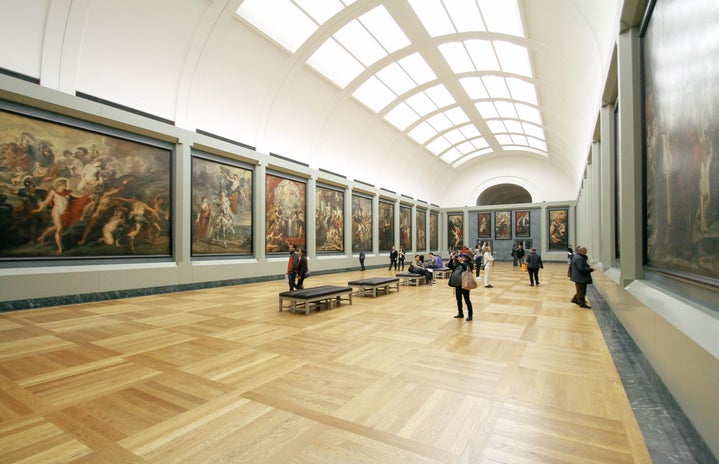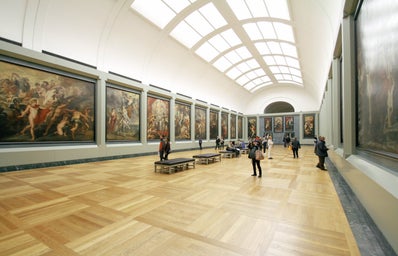I am a simple woman. Put me in a museum related to anything I’m even marginally interested in, and I will be reading every single word on every sign in every exhibit. On school field trips, this has often led to me getting lost or separated from the group as everyone else moves through the exhibits entirely too fast; on family trips, it’s led to frequent complaining by my younger brothers about how I won’t let us leave. Personally, I intend to get my maximum money’s worth by acquiring all the knowledge the place has to offer. There’s nothing I love more than a good museum crawl. Here are a few of my favorites that I’ve visited in my lifetime so far.
- Mashantucket Pequot Museum
Starting off strong, we have a museum I have visited on field trips for not one but two different classes this semester (anthropology major for the win). The first time I went to this museum was actually in third grade, also for a field trip. I remembered it being really cool, but before my first field trip a few weeks ago, I wondered how well these childhood memories would hold up after more than a decade. Let me tell you: it was as awesome as I remembered, and then some. The moment I went down the escalator into a structure designed to look like a glacier, and entered the exhibit on the history of Pequot land tracing back to the last glacial maximum of the Ice Age, I was hooked. This museum has components to its exhibits that speak to literally all of my interests: geology, climatology, ecology, archaeology, mythology and oral tradition, Indigenous agricultural and hunting practices, medicinal plant uses, linguistics … I was soon separated from the rest of the group as I slowed down to read absolutely everything, and I couldn’t stop taking pictures and writing things down in my Notes app to further research. When I saw the display on extinct megafauna (mammoths and dire wolves and such) and the theories as to whether humans or natural climate change killed them, I literally started skipping through the exhibit. I am so hype about that place and the way it combines so many fascinating aspects of the history of this land. I also really love how much attention it gives to Pequot life and culture prior to European colonization. While colonial history is certainly discussed as well, it’s not presented as if Europeans’ arrival was the beginning of history (which is how many museums tend to depict it); it’s just another piece of the story. As someone who is not Indigenous, and sometimes struggles to feel connected to a specific place as home — my family moved around often when I was younger because of the military, and nowadays I’m questioning if I really want to keep living in America beyond graduation — I feel I have so much to learn from a culture and stories that are so intimately connected to specific places.
- Denver Museum of Nature and Science
This museum holds an immense amount of nostalgia for me, as I’ve been coming here for pretty much my entire life. My grandparents live in the Denver area, and every time we visit them (usually twice a year), I’m sure to go to the science museum at least once. I especially love the “Prehistoric Journey” exhibit, which starts with the formation of the earth and the biochemical beginnings of life, then takes you through all the geological eras. You’ll see the unfolding of the Cambrian explosion, the inconceivably giant insects of the Carboniferous, the devastation of the Permian extinction, the iconic dinosaurs of the Mesozoic, the rise of the mammals, and the evolution of humanity’s ancestors. I never get tired of it; the exhibit feels like a pilgrimage for me. I’m also a big fan of the space exhibit and the wildlife halls, although the endless rooms of taxonomied animals can definitely feel unnerving. This summer, the museum had some temporary exhibitions I really enjoyed as well. One was called “The Power of Poison,” focusing both on the evolution and role of poisons in nature, and on the use of toxins (both intentional and unintentional) by humans throughout history. Another focused on orcas, which are one of my favorite animals. That one included a lot of information about orca biology and social behavior as well as their relationship with human cultures, especially the Indigenous peoples of the Pacific Northwest. It was so incredibly cool. Maybe I’m biased by my general love for family visits to Colorado, but I just really adore the Denver museum. It has a lot of in-depth information while still having many interactive exhibits that are accessible to children.
- Rijksmuseum
I went to Amsterdam in January of this year during my winter break, and while I was only there for a few days, this museum definitely stands out in my mind as a highlight of the trip. The Rijksmuseum is the national museum of the Netherlands and therefore focuses on Dutch art and history. I had one of the pairs of headphones offered by the museum for a self-guided audio tour, in which every work of art was assigned a number, and I could learn more about it by entering the number on a keypad. It all felt accessible and interesting without being overwhelming. One painting that stood out to me as memorable was View of Olinda, Brazil by Frans Jansz Post, because I was quite amused by its lineup of animals depicted. In the bottom left, a saggy sloth is splayed out on the ground fighting for his life, because sloths really aren’t meant to be in that position. On either side of him, we see an anteater and an armadillo — the holy trinity of xenarthrans, one of the best mammal orders out there (as I’ve elaborated upon in An Ode to Pink Fairy Armadillos and My Other Favorite Xenarthrans). Some of the old paintings of tropical landscapes did have descriptions making note of the colonialism and slavery that the Dutch used to profit off of these exotic landscapes. I’d been so caught up in enjoying the beauty of a European city that I’d forgotten about the dark side of where the wealth came from, and I think it was a good thing to be reminded.
- Cahokia Mounds World Heritage & State Historic Site
When I was eleven to thirteen years old, I lived in southern Illinois, near St. Louis. I am not cut out for the Midwest princess life, and there were very few things I liked about that place, but one really cool thing does stand out in my memory: the Cahokia Mounds. The historic site is home to dozens of earthen mounds, the largest mound nearly 100 feet tall, that remain as evidence of the Mississippian Indian civilization that flourished in the eleventh and twelfth centuries. At its peak, Cahokia is estimated to have had a population of around 20,000 people, which is comparable to major European cities at the time. Archaeological evidence shows that the Mississippians had a network of trade extending up and down the river, as they had items such as shells and shark teeth that had been traded all the way up from the Gulf of Mexico. The visitor center showed the complexity of their organized society, as well as comparing its timeline to better-known events that were happening elsewhere in the world, and I was really blown away to learn about this side of history I’d never known about before.
- National Museum of African American History and Culture
I visited this museum on my eighth-grade class trip to Washington D.C., so it’s been a few years, but I would really like to go back. I remember this museum being a huge eye-opener for me, as I had just begun to learn about some of the worst atrocities of American history, and the museum really helped me understand the extent of these horrible and difficult stories. The cruelty and brutality that African Americans have endured for centuries, and the courage and resilience it takes to fight these systems of oppression, was (and still is) completely mind-blowing to my privileged, sheltered self. As heavy as the subject matter was, I found it fascinating and very informative. I think this museum presents some hard truths and stories that every American needs to know as we fight for an equitable, anti-racist future.
- Boston Museum of Science
I’ve been to this museum a number of times, the most memorable trip being the overnight I did there with my Girl Scout troop when I was ten. I remember sleeping on the floor next to the T-rex skeleton and getting to use the men’s bathrooms because there were only Girl Scouts left in the building (we were quite excited about this novelty). I also have lovely memories of playing in the “Science in the Park” exhibit, where swings, seesaws, and the like are used to demonstrate the laws of physics. Returning for a visit this summer, I was charmed by a temporary exhibit called “Survival of the Slowest,” which featured a number of live animals (this museum is actually a registered zoo) of species that specialize in the lethargic lifestyle. Once again, huge shoutout to sloths. A concept that you wouldn’t think could work, but executed flawlessly, no notes. I really liked the exhibit on different New England ecosystems as well. I could wander the halls of museums forever, but at some point they’ll inevitably remind me how much I love being outdoors too.
These are just a few of the museums that stand out in my memory. I have a list of many more museums I hope to visit or revisit in the near future. My mother jokes that they lower the oxygen content of the air inside museums on purpose, and that’s where the “museum fatigue” phenomenon comes from. I think my brain needs the knowledge in museums even more than it needs oxygen, because it wouldn’t even bother me if museums were truly doing this. There is nowhere that I feel more in my element.


